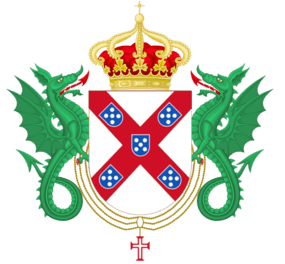Duarte Pio, Duke of Braganza
| Duarte Pio | |||||
|---|---|---|---|---|---|
| Duke of Braganza (more...) | |||||
.jpg) Duarte Pio speaking at the Royal Dinner of the Forty Conspirators; 2008. | |||||
| Head of the Royal House of Portugal | |||||
| Tenure | 24 December 1976 – present | ||||
| Predecessor | Duarte Nuno | ||||
| Heir apparent | Afonso, Prince of Beira | ||||
| Born |
15 May 1945 Bern, Switzerland | ||||
| Spouse | Isabel Inês Castro Curvelo de Herédia (m. 1995) | ||||
| Issue details... |
Afonso, Prince of Beira Infanta Maria Francisca Infante Dinis, Duke of Porto | ||||
| |||||
| House | House of Braganza | ||||
| Father | Duarte Nuno, Duke of Braganza | ||||
| Mother | Maria Francisca of Orléans-Braganza | ||||
| Religion | Roman Catholicism | ||||
Dom Duarte Pio, Duke of Braganza (born 15 May 1945), is the pretender to the former Portuguese throne, as the head of the House of Braganza. The Miguelist Braganzas, to whom Duarte Pio belongs as great-grandson of King Miguel I, is a cadet branch of the House of Braganza. With the extinction of male-line dynasts descended from Queen Maria II in 1932, King Miguel's descendants became the only male-line Braganzas left and the closest male-line heirs to the Portuguese throne (the Brazilian branch having gone extinct in 1921).
Duarte Pio is a figure within the European network of royal houses, often being invited to various foreign royal events. Despite his support for a monarchical government and widespread recognition as heir to the throne, there are no serious movements or parties that support restoration of the monarchy.
In 1995, the Duke married Isabel Inês de Castro Curvelo de Herédia, a Portuguese businesswoman and descendant of lesser Portuguese nobility. Their marriage was the first marriage of a Portuguese royal to happen in Portuguese territory since the marriage of King Carlos I, Duarte Pio's second cousin once removed, and Princess Amélie of Orléans, in 1886. The Duke and Duchess have three children, thus continuing the line of the Braganzas, as neither of the Duke's brothers have married nor had children.
Early life

Duarte Pio João Miguel Gabriel Rafael was born on 15 May 1945 in Bern, Switzerland, as the first of three sons of Duarte Nuno, Duke of Braganza, and Maria Francisca of Orléans-Braganza. His father was the grandson of King Miguel I, while his mother was a great-granddaughter of King Pedro IV (Emperor Pedro I of Brazil), who was King Miguel I's older brother. Through his father, he is a member of the Miguelist branch of the House of Braganza. Duarte Pio's godparents were Pope Pius XII, Queen Amélie (the mother of King Manuel II, the last monarch of Portugal) and his great-aunt Infanta Adelgundes, Duchess of Guimarães.[1] From his birth, Duarte Pio has held the honorific styling of Dom (Lord) and the styling of His Royal Highness and, until the death of his father, he held the titles of Prince of Beira and Duke of Barcelos.[2]
The Duke is regarded as a Portuguese national by descent, since his father was Portuguese (and so Duarte Pio's birth was legitimately included in the Portuguese Civil Registry). At the time of his birth, Duarte Pio and the rest of the Miguelist Braganzas were banned from entering Portugal, by the laws of exile of 19 December 1834.[3] On 27 May 1950, the Portuguese National Assembly revoked both the laws of exile from 19 December 1834, which banned the Miguelist Braganzas, and the laws of exile from 15 October 1910, which banned the Legitimist Braganzas.[4] In 1951, Dom Duarte visited Portugal for the first time, accompanied by his aunt, Infanta Filipa. In 1952, he moved to Portugal permanently with his parents and brothers.
From 1957 to 1959, Duarte was enrolled in the Colégio Nun'Álvres in Santo Tirso. In 1960, he entered the Colégio Militar in Lisbon.[2] He attended the Instituto Superior de Agronomia (now part of the Technical University of Lisbon) and later the Graduate Institute of Development Studies of the University of Geneva.
From 1968 to 1971, Dom Duarte fulfilled his military service as a helicopter pilot in the Portuguese Air Force in Portuguese Angola at the time of the Portuguese Colonial War. In 1972, he participated with a multi-ethnic Angolan group in the organization of an independent list of candidates to the National Assembly. This resulted in his expulsion from Angola by order of the Prime Minister Marcelo Caetano.
Succession
Duarte Pio claims the throne[5] as the heir of King Manuel II according to the Constitutional Charter of 1826. A small number of Portuguese monarchists do not recognise Duarte Pio as pretender to the throne or as Duke of Braganza. The dispute dates back to 1828 when Duarte Pio's great-grandfather usurped the throne as King Miguel I. Miguel I was eventually exiled and his niece, Queen Maria II, was restored to her throne. According to the law of banishment (Lei do Banimento) of 1834 and the Constitution of 1838, Miguel I and all his descendants were forever excluded from the succession to the throne. However, the Constitutional Charter of 1826 was reinstated in 1842; this constitution (which was in place until 1910 when the monarchy was overthrown) did not bar Miguel's descendants from ascending the throne.[6]
In 1912 and 1922, Duarte Pio's grandfather, Miguel, Duke of Braganza, reconciled with King Manuel II, but this reconciliation was not accepted by all of their adherents. There are several monarchist organizations in Portugal which maintain that only the Cortes or the National Assembly could legally determine the rightful claimant if ever Portugal decided to restore the monarchy. One monarchist group in Portugal that did support Miguel, Duke of Braganza, instead of the deposed King Manuel II was the Integralismo Lusitano.
Parliamentary statements
In May 2006, the Portuguese Ministry of Foreign Affairs issued a statement where it referred to Duarte Pio as Duke of Braganza.[1] On 5 July 2006, in response to this statement, Nuno da Câmara Pereira, member of the Portuguese parliament and then leader of the People's Monarchist Party, addressed the President of the Assembly of the Republic, asking for a clarification as to the official recognition of Duarte Pio as pretender to the throne and as Duke of Braganza. In its official response on 11 July 2006, the Ministry of Parliamentary Affairs restated the fact that the Portuguese constitution guarantees the republican regime.
Roles and positions
The Duke often interacts with both national and international political and cultural institutions, by which he represents the Portuguese people and their culture. Though not a head of state or official representative of the Portuguese state, Duarte Pio has been received with such honours by various foreign heads of state, government, and organizations.
Politics
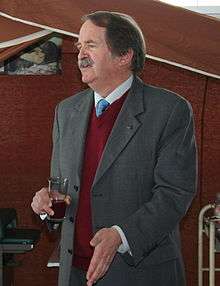
Dom Duarte was a major campaigner for the independence of Timor-Leste, a former Portuguese colony which was forcibly annexed by Indonesia in 1975. Before the issue's global popularity from the 1990s onward, the Duke contributed with several national and international campaigns for the political self-determination of the territory, including Timor 87 Vamos Ajudar and Lusitânia Expresso.[7] In 1997, Dom Duarte also suggested a referendum on the independence of East Timor to the Indonesian Vice-President Jusuf Habibie. After Habibie became president of Indonesia in 1999, a referendum was held that resulted in the independence of the country.
In December 2010, Timor-Leste President José Ramos-Horta expressed his interest in making Duarte Pio a Timorese citizen, by which the Duke accepted, because of the "profound and spiritual relations of the Timorese people with Portugal", continuing by saying that the symbols of the House of Braganza have a "great significance" in Timor-Leste.[8] In February 2012, with final approval and support of Timor-Leste parliament, President Ramos-Horta conferred Timorese citizenship unto Duarte Pio, along with the Order of Merit.[9][10] President Ramos-Horta stated that these honours were given because of Duarte Pio's "dedication of a large part of his life to defending justice and liberty for the Timorese people".[11]
In September 2011, President Bashar al-Assad of Syria invited the Duke on a state visit to Damascus.[12] The Duke stated he was invited by President al-Assad with the intention that Duarte Pio relay the Syrian head of state's plans and intents for Syria and its people.[13] Duarte Pio told several Portuguese news outlets that it was the Syrian President's intention to "collaborate on the creation of a future constitution for Syria, close to that of Marocco, which guarantees political, religious, and press freedom."[14] Alongside communicating the political and reformist intentions of the Syrian President, Duarte Pio stated that President al-Assad was a "good and well-intentioned man" and that "since he has assumed power, he has tried to democratize and humanize politics and [that] he has already achieved great advancements."[15]
In his capacity as the President of the King Manuel II Foundation, Duarte Pio is often involved with the Community of Portuguese Language Countries, intergovernmental organization for economic, political, and cultural friendship between Portugal and many of its former colonies. In 2009, the Duke petitioned for the King Manuel II Foundation to become a consultative observer within the CPLP, but with no success.[16] In 2012, Duarte Pio petitioned, with Maria Hermínia Cabral, Director of the Calouste Gulbenkian Foundation, for their respective organizations to become CPLP consultative observers, to which both succeeded in their endeavor.[17][18] In November 2012, for a meeting of the consultative observers of the CPLP the Duke visited Mindelo, Cabo Verde.[19][20] While there, the Duke visited various locations within Cabo Verde, and was received by President Jorge Carlos de Almeida Fonseca.[21][22] During the visit, Duarte Pio decorated President Almeida Fonseca with the Order of the Immaculate Conception of Vila Viçosa. Duarte Pio often visits various municipalities around the country, in an official charge, for economic and political events. On 14 November 2007, the Duke visited the Santiago do Cacém Municipality and was received with honours by the President of the Municipality, in the Palace of the Concelho.[23] On 11 October 2011, Duarte Pio visited the freguesia of São Pedro de Oliveira, in Braga, and was received with honours by the President of the Freguesia Augusto de Carvalho.[24] On 28 March 2012, the Duke and his son, Afonso, Prince of Beira, were guests of honour at the XII Exposition of Folar and Products of the Earth, an exposition staged for the purpose of economic promotion of products from the Valpaços Municipality.[25]
On 2014, the Court of Lisbon forbid Duarte Pio of Braganza to use the insignia of the Order of Saint Michael of the Wing and demanded him to compensate 300,000 euro to the legal owners of the rights, Nuno Pereira da Camera, who allegedly registered the name "Order of Saint Michael of the Wing" (Portuguese: "Ordem de São Miguel da Ala") in 1981, whereas Duarte Pio is said to have registered it in 2004.[26] The condemnation was repeated on October 5, 2015.[27] However, on November 3, 2015, the rights of Nuno Pereira da Camera to the symbols was lost,[28] and on December 7th, Duarte Pio of Braganza won the case and regained the legal rights.[29]
Culture
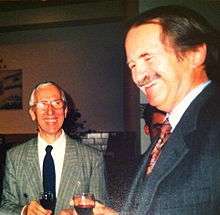
Duarte Pio often travels and visits various places, in an official charge, for matters concerning cultural affairs, both in Portugal and overseas. From 24 until 25 May 2009, the Duke visited Terceira Island, in the Azores Autonomous Region, as a guest of honour of the Santa Casa da Misericórdia, for the presentation of Mendo Castro Henriques's book, Dom Duarte e a Democracia – Uma Biografia Portuguesa.[30] While in Terceira, Duarte Pio was received with honours by the President of the Municipality of Praia da Vitória and attended and visited various cultural and religious institutions and events, including a dinner at the Santa Casa da Misericórdia and assisting in a Portuguese bullfight.[31]
On 12 September 2011, the Duke, as President of the Henry the Navigator Award, a partner award of the Duke of Edinburgh's Award, visited Funchal, in the Madeira Autonomous Region, for an official visit. While there, the Duke was received with honours by Miguel Albuquerque, President of the Municipality of Funchal, visited the Municipal Gardens of Funchal and held a ceremony for the presentation of the Henry the Navigator Award.[32][33] On 30 September 2011, Duarte Pio visited Vila Franca de Xira, as a guest of honour for the Royal Tourada, and visited various cultural institutions of the municipality, including the Museum of Neo-Realism and the Celeiro da Patriarcal.[34] On 8 January 2012, the Duke visited the Vila Verde Municipality, as a special guest of the Association for Regional Development of Minho, where he attended an exhibition on regional culture and products and was presented a traditional Lenço de Namorados, made in 1912.[35]
Every year, on 1 December, Restoration Day, the Duke gives his annual speech in honour of the Portuguese Restoration at the dinner of the Forty Conspirators.[36] It was on 1 December 1640 that João II, Duke of Braganza, an ancestor of Duarte Pio, deposed the Portuguese House of Habsburg, installed the House of Braganza as the reigning house of Portugal, and restored sovereign rule to the Portugal. In his speeches, the Duke reflects on the historical significance of the date, events of the previous year, and the road ahead for both Portugal in general and the monarchist cause. In 2012, Restoration Day ceased to be an official holiday of the Portuguese state, prompting Duarte Pio to speak out against the action, stating that extinction of the official holiday "devalues the day which should unite the Portuguese".[37][38]
Marriage
On 13 May 1995, Dom Duarte Pio married Isabel Inês de Castro Curvelo de Herédia, a Portuguese businesswoman and descendant of nobility. This was the first marriage of a member of the Portuguese royal family to take place in Portugal since the marriage of King Carlos I in 1886. The ceremony was celebrated in the Monastery of Jerónimos in Lisbon and presided over by Cardinal António Ribeiro, Patriarch of Lisbon. It was attended by the principal Portuguese political figures, including the President of the Republic Mário Soares, the President of the Assembly of the Republic, and the Prime Minister Aníbal Cavaco Silva. Representatives of most of the European royal houses were also present.
Titles, honours, and styles
| Portuguese Royal Family |
.png) |
|
HRH The Duke of Braganza |
Titles
Royal dynastic orders
As head of the House of Braganza, Duarte Pio is:
 Portugal: Grand Master and Sovereign of the Order of the Immaculate Conception of Vila Viçosa
Portugal: Grand Master and Sovereign of the Order of the Immaculate Conception of Vila Viçosa Portugal: Grand Master of the Order of Saint Michael of the Wing
Portugal: Grand Master of the Order of Saint Michael of the Wing Portugal: Sovereign of the Order of Saint Isabel
Portugal: Sovereign of the Order of Saint Isabel
Foreign honours
-
.svg.png) Castroan Royal Family of Two Sicilies: Knight Grand Cross with Collar of the Castroan Order of Saint Januarius[39]
Castroan Royal Family of Two Sicilies: Knight Grand Cross with Collar of the Castroan Order of Saint Januarius[39] -
.svg.png) Calabrian Royal Family of Two Sicilies: Bailiff Knight Grand Cross with Collar of Justice of the Calabrian-Two Sicilian Sacred Military Constantinian Order of Saint George[40]
Calabrian Royal Family of Two Sicilies: Bailiff Knight Grand Cross with Collar of Justice of the Calabrian-Two Sicilian Sacred Military Constantinian Order of Saint George[40] -
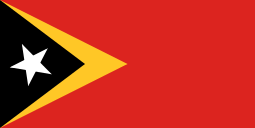 Timor-Leste: Grand Collar of the Order of Timor-Leste[41]
Timor-Leste: Grand Collar of the Order of Timor-Leste[41] -
 Yugoslavian Royal Family: Knight Grand Cross of the Order of the Star of Karađorđe[42]
Yugoslavian Royal Family: Knight Grand Cross of the Order of the Star of Karađorđe[42] -
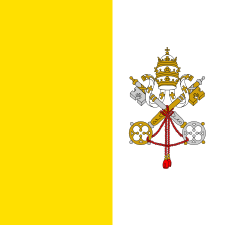 Vatican: Knight Grand Cross of the Order of the Holy Sepulchre[43]
Vatican: Knight Grand Cross of the Order of the Holy Sepulchre[43]
Genealogy
Relation to the last monarch
Ancestry
Issue
| Name | Portrait | Birth | Notes |
|---|---|---|---|
| By Isabel Inês de Castro Curvelo de Herédia (22 November 1966 – present; married 13 May 1995) | |||
| Afonso, Prince of Beira | 25 March 1996 | 16th Prince of Beira, 18th Duke of Barcelos; 1st in line of succession | |
| Infanta Maria Francisca | 3 March 1997 | Infanta of Portugal; 3rd in line of succession | |
| Infante Dinis, Duke of Porto | 25 November 1999 | 4th Duke of Porto, Infante of Portugal; 2nd in line of succession | |
References
- 1 2 "Disputa na sucessão dinástica portuguesa". Retrieved 21 December 2008.
- 1 2 Liga de Amigos do Colégio Militar – D. Duarte Pio de Bragança
- ↑ Portvgal – Lei de Banimento: Carta de Lei, de 19 de Dezembro de 1834
- ↑ Revogação das leis sobre Banimento e Proscrição da Família Real
- ↑ Minet, Paul (May 1996). "Royal Births". Royalty Digest. V. No. 11: 316. ISSN 0967-5744.
- ↑ Assembleia da Republica “But the Constitutional Charter was revived for two subsequent periods: from August 1834 (when Dom Miguel left the country) to the resolution of September 1836 (which restored the Constitution of 1822 until the approval of the Constitution of 1838) and from January 1842 to October 1910.”
- ↑ Bragança, Duarte Pio de (September 2001). "Timor, que future?". Portvgal. Retrieved 13 January 2013.
- ↑ Lemos, Sérgio (1 December 2010). "D. Duarte já pediu nacionalidade timorense". Correio da Manhã. Retrieved 13 January 2013.
- ↑ Lusa (10 February 2012). "Dom Duarte recebe nacionalidade timorense". Diário de Notícias. Retrieved 13 January 2013.
- ↑ Lusa (10 February 2012). "Duque de Bragança recebe nacionalide timorense". Sapo Timor-Leste Notícias. Retrieved 13 January 2013.
- ↑ Lusa (13 February 2012). "Duque de Bragança cidadão timorense". Diário de Notícias. Retrieved 13 January 2013.
- ↑ RTP TeleJornal – D. Duarte de Bragança Traz Recado de Al-Assad
- ↑ Expresso – D. Duarte Fez Viagem Diplomática à Síria
- ↑ Sol – D. Duarte: Ditador Sírio é 'Muito Bem Intencionado'
- ↑ SIC Notícias – Mário Crespo Entrevista D. Duarte Pio
- ↑ CPLP – Candidatura da Fundação D. Manuel II a observador consultivo da CPLP
- ↑ MSN Notícias – CPLP: Parceria entre instituições é necessária para o funcionamento do fórum da sociedade civil
- ↑ Sapo Timor-Leste Notícias – Parseria entre instituisaun sira importante tebtebes ba funsionamentu husi fórum sosiedade sivil nian
- ↑ Cabo Verde Directo – PR recebe Duque de Bragança
- ↑ Radiotelivisão Caboverdiana – Duque de Bragança, Dom Duarte visita PR
- ↑ Binókulo: Jorge Carlos Fonseca recebe no Palácio do Plateau Dom Duarte, Duque de Bragança
- ↑ Liberal – Duque de Bragança visita hoje o Presidente da República
- ↑ Alentejo Litoral – D. Duarte Pio visita Santiago do Cacém
- ↑ Gazeta de Visue – Visita de S.A.R., o Duque de Bragança Dom Duarte Pio a Oliveira São Pedro
- ↑ Real Associação de Trás-os-Montes e Alto Douro – Visita de SS. AA. RR., o Senhor Dom Duarte, Duque de Bragança e do Infante Dom Afonso de Santa Maria, Príncipe da Beira, à XII Feira do Folar e dos Produtos da Terra
- ↑ D. Duarte de Bragança condenado pelo Tribunal do Comércio de Lisboa
- ↑ O.S.M.A. - Processo 93.07 - Acórdão do Supremo Tribunal de Justiça 05-10-2015
- ↑ http://www.flashvidas.pt/a_ferver/detalhe/nuno_da_camara_pereira_perde_marca_real.html
- ↑ http://www.flashvidas.pt/a_ferver/detalhe/duarte_pio_absolvido_pelo_tribunal.html
- ↑ Causa Monárquica – D. Duarte Pio na ilha Terceira
- ↑ Monarquia Portuguesa – Visita de SAR D. Duarte Pio à Terceira, a 25 de Maio de 2009
- ↑ Diário de Notícias Madeira – Duque de Bragança vem ao Funchal
- ↑ C.M. Funchal – Dom Duarte, Duque de Bragança visita Hortas Municipais do Funchal
- ↑ O Mirante – O duque de Bragança, Dom Duarte Pio, visitou na tarde de sexta-feira, 30 de Setembro
- ↑ Adere-Minho – Dom Duarte Pio de Bragança visita Adere-Minho e recebe Lenço de Namorados do Minho certificado (réplica original de 1912)
- ↑ Causa Monárquica – D Duarte Pio e o 1º de Dezembro
- ↑ Públio – Extinção do 1.º de Dezembro desvaloriza dia que mais devia unir os portugueses, diz Duarte Pio
- ↑ MSN Notícias – Extinção do 1.º de Dezembro desvaloriza dia que mais devia unir os portugueses, Duarte Pio
- ↑ http://www.constantinian.org.uk/illustrious-royal-order-of-saint-januarius/
- ↑ http://www.constantinianorder.org/history/the-activities-of-the-order-since-1960.html
- ↑ "Decreto Presidente 7/2012". Government of East Timor. Retrieved 7 February 2016.
- ↑ http://www.royalfamily.org/history/spisakodlikovanih.html
- ↑ Blogspot
Further reading
- Henriques, Mendo Castro. Dom Duarte e a Democracia: uma biografia portuguesa. Lisbon: Bertrand, 2006. ISBN 972-25-1517-9
- Mendes, Nuno Canas. Duarte e Isabel, duques de Bragança: biografia autorizada. Mem Martins: Lyon Multimédia Edições, 1995.
- Morais, Jorge. D. Duarte: a primeira biografia. Lisbon: Chiado-Consultores de Informação, 1995.
- Fernandes, Clara Picão. Monarquia hoje?: diálogos com o Duque de Bragança. Lisbon: Editora Civilização, 1995.
External links
| Wikimedia Commons has media related to Duarte Pio, Duke of Braganza. |
- Fundação da Casa de Bragança Website of the Foundation of the House of Braganza.
| Duarte Pio, Duke of Braganza Cadet branch of the House of Aviz Born: 15 May 1945 | ||
| Titles in pretence | ||
|---|---|---|
| Preceded by Duarte Nuno |
Duke of Braganza 24 December 1976 – present |
Incumbent Heir: Afonso de Santa Maria Prince of Beira |
| Vacant Title last held by Luís Filipe |
Prince of Beira Duke of Barcelos 15 May 1945 – 24 December 1976 |
Succeeded by Afonso de Santa Maria |
| Preceded by Duarte Nuno |
— TITULAR — King of Portugal and the Algarves 24 December 1976 – present Reason for succession failure: Kingdom abolished in 1910 |
Incumbent Heir: Afonso de Santa Maria Prince of Beira |
